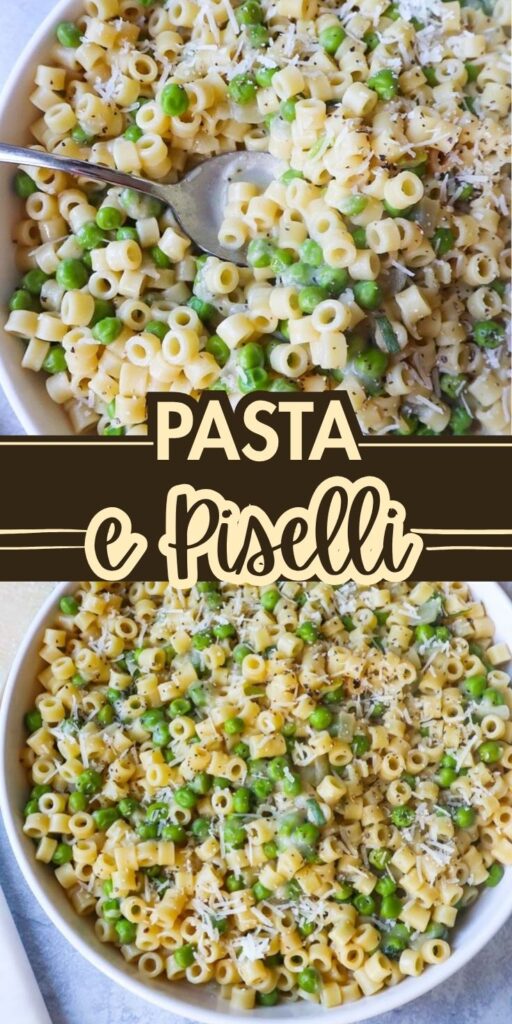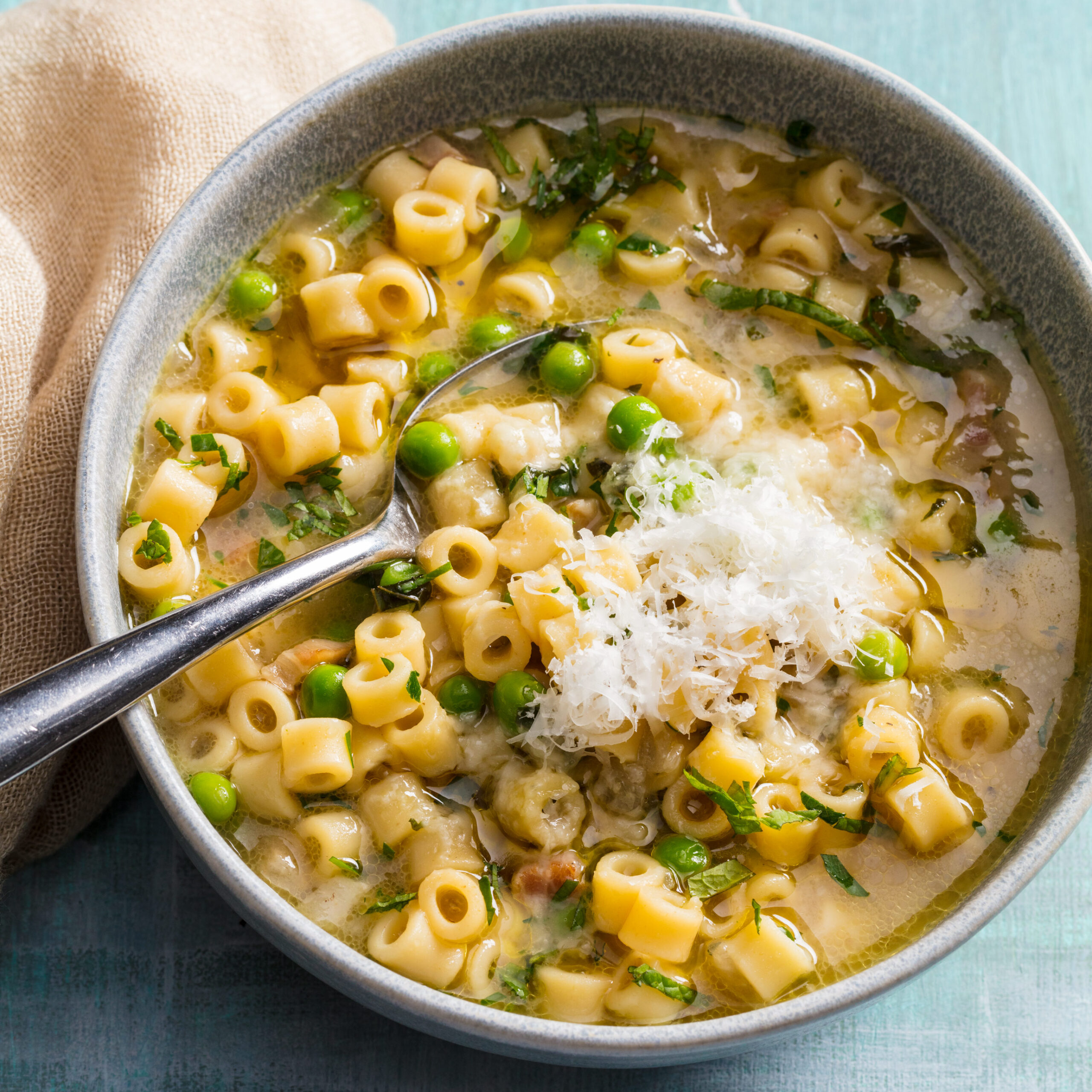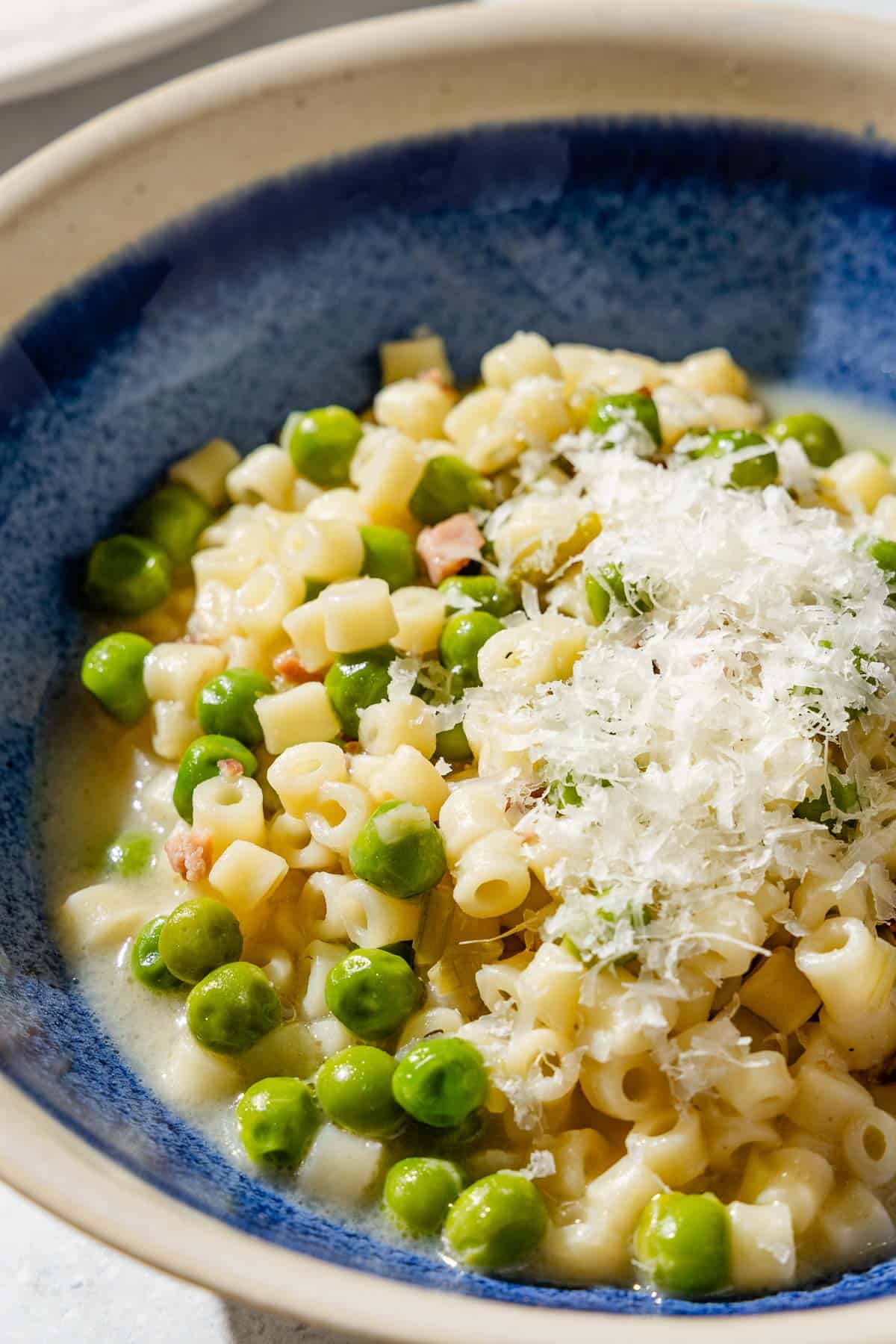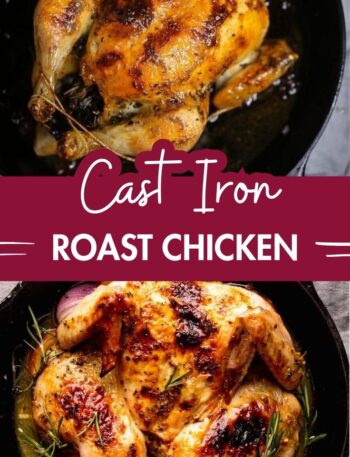
Pasta e Piselli is a comforting Italian dish that combines pasta and sweet green peas in a simple, flavorful broth. Originating from Southern Italy, particularly Naples, it reflects the region’s love for rustic, affordable home cooking.
Traditionally made with small pasta shapes like ditalini and enhanced with onions, olive oil, and sometimes pancetta or Parmesan, it’s both nourishing and budget-friendly.
Pasta e Piselli is often enjoyed as a quick weekday meal, especially in spring when peas are fresh and abundant. Its creamy texture, despite having no cream, makes it a beloved staple in many Italian households.
Pasta e Piselli is a humble, comforting dish rooted in the heart of southern Italy, particularly Naples. This budget-friendly and satisfying recipe makes the most of pantry staples like pasta and frozen or fresh green peas.
Cooked all in one pot, this dish is ideal for busy weeknights or cozy evenings when you’re craving something warm, simple, and full of flavor.
Despite its simplicity, Pasta e Piselli carries immense cultural and nostalgic value in many Italian households. It’s one of those meals every Nonna has made, often with a personal touch—perhaps a little pancetta, a dash of chili flakes, or an extra splash of olive oil. Traditionally meatless, it’s also a great vegetarian meal and can be easily made vegan.
Pasta e Piselli
Description
Pasta e Piselli is a comforting Italian dish combining tender pasta and sweet green peas in a light, flavorful broth.
Often made with simple pantry ingredients like onions, garlic, olive oil, and sometimes pancetta, this rustic recipe showcases the elegance of minimalism.
The pasta—typically ditalini or small shells—cooks in the same pot, absorbing the starchy, savory liquid for a creamy texture. Finished with a touch of Parmesan cheese and fresh herbs, Pasta e Piselli is warm, nourishing, and quick to prepare.
It’s a beloved classic in Italian home cooking, especially popular during spring when fresh peas are in season.
Ingredients
Instructions
-
In a medium pot, heat the olive oil over medium heat. Add the chopped onion and a pinch of salt. Cook, stirring occasionally, until the onion is soft and translucent, about 5–6 minutes. If you’re using garlic, add it during the last minute to prevent burning.
-
Stir in the peas and cook for 2–3 minutes. Season with salt and pepper. If you’re using fresh peas, cook slightly longer (around 5–6 minutes) to soften.
-
Pour in the water or vegetable broth and bring to a gentle boil. Taste the liquid and adjust the seasoning, keeping in mind that the pasta will absorb the flavor. If using cheese later, remember it will add saltiness too.
-
Add your pasta directly into the boiling liquid. Stir frequently to prevent sticking. Allow the pasta to cook, uncovered, according to the package instructions, usually 8–10 minutes, until al dente. Stir frequently as the starch released by the pasta will thicken the broth and create a creamy consistency.
Note: You can add more hot water if needed to loosen the mixture or keep it soupy, depending on your texture preference.
-
Once the pasta is cooked and the mixture is creamy (not dry), turn off the heat. Stir in the grated cheese and butter (if using) until melted and well combined. Taste and adjust seasoning again, if needed.
Nutrition Facts
Servings 4
- Amount Per Serving
- Calories 400kcal
- % Daily Value *
- Total Fat 15g24%
- Saturated Fat 2g10%
- Cholesterol 10mg4%
- Sodium 500mg21%
- Total Carbohydrate 55g19%
- Dietary Fiber 6g24%
- Sugars 4g
- Protein 14g29%
- Calcium 200 mg
* Percent Daily Values are based on a 2,000 calorie diet. Your daily value may be higher or lower depending on your calorie needs.
Note
Pasta e Piselli, or pasta with peas, is a humble yet comforting Italian dish, traditionally made with pantry staples like pasta, green peas, onion, and Parmesan.
Despite its simplicity, a few thoughtful tips and serving tricks can elevate this meal from ordinary to extraordinary.
Tips for Making the Best Pasta e Piselli
1. Choose the Right Pasta Shape
Traditionally, Pasta e Piselli uses small shapes like ditalini, tubetti, or even broken spaghetti. These pasta types absorb the flavors better and create a risotto-like texture. If you don’t have those on hand, try elbow macaroni or orzo, but avoid long pasta like linguine or fettuccine.
2. Use Sweet Peas (Frozen or Fresh)
Frozen peas are a great choice for this recipe as they’re picked at peak ripeness. If using fresh peas, be sure to shell and cook them properly. Avoid canned peas—they tend to be too soft and dull in flavor.
3. Don’t Overcook the Peas
Add the peas halfway through cooking. Overcooking turns them mushy and grey. Cook just enough so they remain bright green and slightly sweet.
4. Create a Creamy Base (Without Cream)
One of the secrets to a luscious Pasta e Piselli is using starchy pasta water and mashing some peas during cooking. Stir vigorously to release the starch from the pasta. This technique helps achieve a creamy consistency without needing any dairy or cream.
5. Use a Flavor Base
Start with a soffritto: sauté finely chopped onion (or shallot) in olive oil or butter until translucent. Some families also add pancetta or guanciale for depth, but it’s delicious even vegetarian. Garlic can be added, but in moderation—it shouldn't overpower the sweetness of the peas.
6. Parmesan Rind Bonus
Simmer a piece of Parmesan rind in the broth while the pasta cooks. It infuses incredible umami flavor into the dish. Remove before serving.
7. Taste the Broth
Whether using water, vegetable broth, or chicken stock, make sure it’s seasoned well. The broth becomes the soul of the dish, so under-seasoning it can make everything taste flat.
8. Don’t Drain All the Liquid
Unlike traditional pasta recipes, you want Pasta e Piselli to be slightly brothy or creamy. Save that pasta water—don’t rinse or drain the pasta completely.
Serving Tricks for Pasta e Piselli
1. Serve Immediately for the Best Texture
Pasta e Piselli is best served right after cooking. Letting it sit too long can cause the pasta to absorb all the liquid and become overly soft. If that happens, add a bit of hot water or broth to loosen it back up.
2. Add Freshness with Herbs
Top with chopped fresh parsley or basil for a burst of freshness. A drizzle of lemon juice or zest can also brighten up the flavors.
3. Offer Toppings
Serve with a bowl of freshly grated Parmesan or Pecorino Romano on the side. For a little heat, offer red chili flakes or a dash of black pepper. Cracked pepper adds complexity to the mild sweetness of the peas.
4. Make It a Meal
Though hearty, you can add extra protein like shredded rotisserie chicken, poached eggs, or crispy pancetta. For a vegetarian twist, add sautéed mushrooms or artichoke hearts.
5. Store and Reheat Smartly
Store leftovers in an airtight container in the fridge for up to 2 days. When reheating, add a splash of water or broth and stir over medium-low heat to bring back the creamy consistency.
Portion and Serving Size Tips
- Standard serving: 1 to 1½ cups per person.
- Main dish: Serve with rustic bread or a side salad.
- As a side dish: Smaller portions (¾ cup) alongside grilled fish, chicken, or Italian sausages.
With its balance of comfort and simplicity, Pasta e Piselli is the perfect weeknight staple. With these tips and tricks, you can turn a simple bowl of pasta and peas into a soul-satisfying experience.
Serving Suggestions
Serve warm, garnished with a sprinkle of extra cheese, freshly cracked black pepper, and chopped fresh parsley or basil. Drizzle with a little extra virgin olive oil for richness.
Pasta e Piselli can be enjoyed as a first course (primo) in a traditional Italian meal or served as a main dish with crusty bread and a side salad.
Tips for the Best Pasta e Piselli
- Use small pasta shapes like ditalini or elbows. These hold up well and create that classic creamy texture.
- Don’t drain the pasta water! Cooking the pasta in the same pot as the peas enhances flavor and naturally thickens the dish.
- Use good cheese. Parmigiano-Reggiano or Pecorino Romano adds a bold umami kick. If you’re vegan, opt for nutritional yeast or a dairy-free alternative.
- Control the consistency. Some people like it brothy, others prefer it thicker, almost like a risotto. Adjust the water/broth to suit your taste.
Variations
- With Pancetta or Bacon:
Add ¼ cup diced pancetta or bacon at the start and cook until crispy before adding onions for a heartier version. - With Tomato:
Add ¼ cup of tomato passata or a spoon of tomato paste after the onions for a slightly tangy twist. - Spicy:
Add red pepper flakes or a diced chili with the garlic for heat. - Creamier Texture:
Stir in a tablespoon of cream or mascarpone at the end. - Gluten-Free:
Use gluten-free pasta, ensuring the cook time and liquid needs are adjusted accordingly.
Seasonal Notes
While Pasta e Piselli is available year-round (thanks to frozen peas), it’s especially delightful in spring when fresh peas are in season. It’s light enough for warm weather and cozy enough for cooler evenings.
Make-Ahead & Storage
- Make-ahead: Best enjoyed fresh, but you can prep the onion-pea base in advance and cook the pasta just before serving.
- Storage: Store leftovers in an airtight container in the fridge for up to 3 days. The pasta will continue to absorb liquid, so add a splash of water or broth when reheating.
- Freezing: Not recommended, as pasta tends to become mushy when thawed.
Final Thoughts
Pasta e Piselli is the epitome of cucina povera—Italian peasant cooking that turns basic ingredients into something soul-satisfying. Whether you’re cooking for yourself, your family, or guests, it brings comfort, warmth, and simplicity to the table.
It’s an ideal dish to customize and keep in your weeknight rotation—a bowl of green-flecked pasta that proves food doesn’t need to be fancy to be utterly delicious.
Frequently Asked Questions
What is Pasta e Piselli?
Pasta e Piselli (pasta and peas) is a classic Italian comfort food made with simple ingredients like pasta, green peas, onion, olive oil or butter, and often cheese or broth.
Traditionally from Southern Italy, especially Naples, it’s a creamy, one-pot dish that’s both satisfying and budget-friendly.
Can I use frozen or canned peas?
Yes! Both frozen and canned peas work well in Pasta e Piselli. Frozen peas are preferred for their freshness and texture, but canned peas are convenient and still delicious. Just be sure to drain and rinse canned peas to reduce excess salt.
What type of pasta is best for Pasta e Piselli?
Small pasta shapes like ditalini, tubetti, or small shells are ideal. These pasta shapes help create a creamy consistency as they release starch while cooking directly in the pot with the peas and liquid. However, broken spaghetti or any short pasta can be substituted in a pinch.
How do I make it vegetarian or vegan?
Pasta e Piselli is easily adaptable. For a vegetarian version, use vegetable broth instead of chicken stock and skip the meat if using pancetta or bacon. To make it vegan, simply omit cheese or substitute it with nutritional yeast or a vegan cheese alternative, and use olive oil instead of butter.








